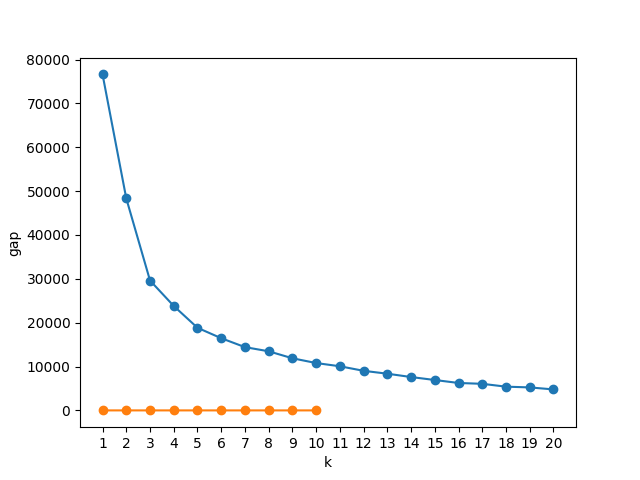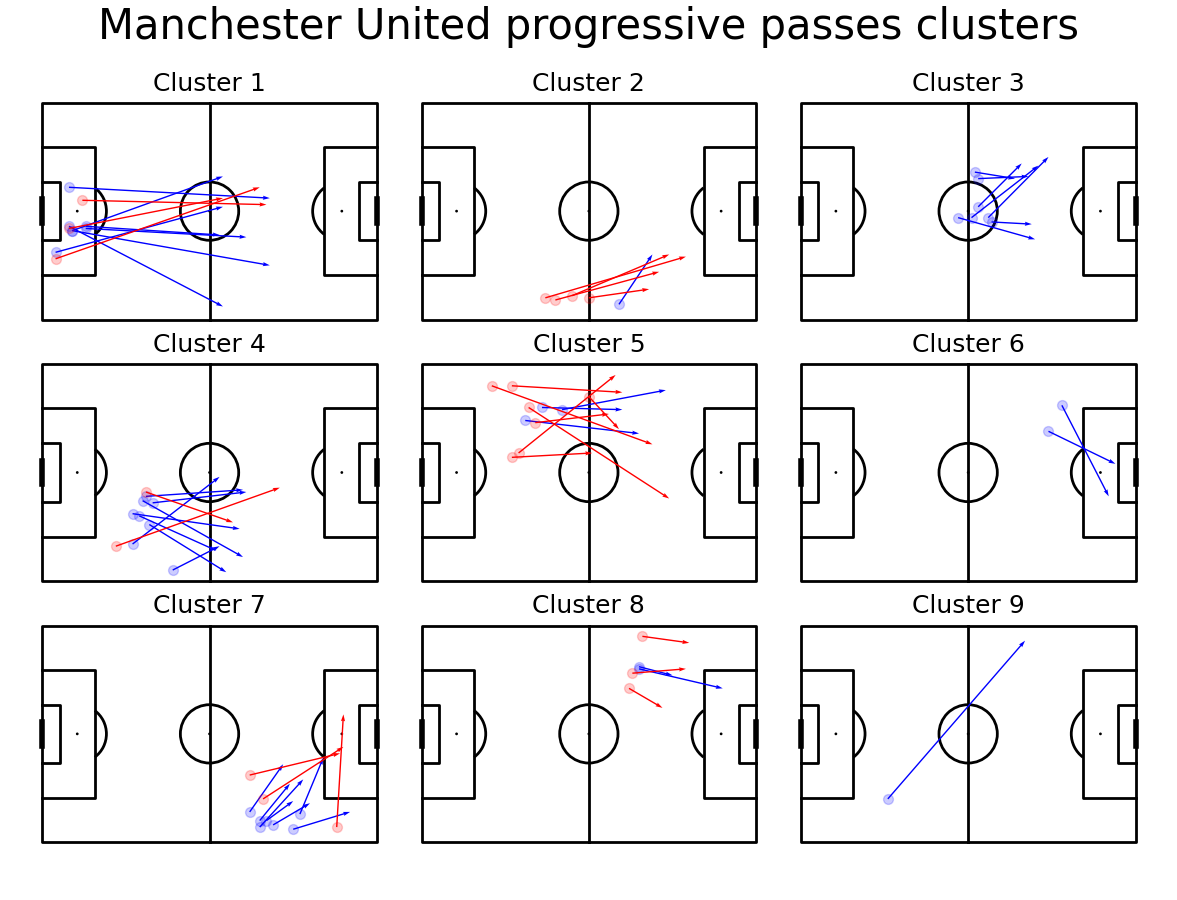Note
Click here to download the full example code
Clustering progressive passes
In this tutorial we show how to cluster progressive passes using KMeans clustering.
#importing necessary libraries
import pandas as pd
import numpy as np
import warnings
import matplotlib.pyplot as plt
from mplsoccer import Pitch
import os
import pathlib
import json
pd.options.mode.chained_assignment = None
warnings.filterwarnings('ignore')
Opening the dataset
First we open the data. It is exactly the same way as we did in the previous tutorials.
df = pd.DataFrame()
for i in range(13):
file_name = 'events_England_' + str(i+1) + '.json'
path = os.path.join(str(pathlib.Path().resolve().parents[0]), 'data', 'Wyscout', file_name)
with open(path) as f:
data = json.load(f)
df = pd.concat([df, pd.DataFrame(data)])
Preparing the dataset
Data preprocessing is also done in a similar manner. First we take the matchId of the game we want to analyze. Then, we filter out passes which ended in (0, 68) or (105, 0) as well as ones that ended out of the pitch. Clustering progressive passes can be also done for on player and the entire season!
#get events from match
match_id = 2500045
#get passes from this match
match_events = df.loc[df["matchId"] == match_id]
next_event = match_events.shift(-1, fill_value=0)
match_events["nextEvent"] = next_event["subEventName"]
match_events["kickedOut"] = match_events.apply(lambda x: 1 if x.nextEvent == "Ball out of the field" else 0, axis = 1)
passes = match_events.loc[match_events["eventName"] == "Pass"]
#change coords to better find progressive
passes["x"] = passes.positions.apply(lambda cell: (cell[0]['x']) * 105/100)
passes["y"] = passes.positions.apply(lambda cell: (100 - cell[0]['y']) * 68/100)
passes["end_x"] = passes.positions.apply(lambda cell: (cell[1]['x']) * 105/100)
passes["end_y"] = passes.positions.apply(lambda cell: (100 - cell[1]['y']) * 68/100)
delete_passes = passes.loc[passes["kickedOut"] == 1]
passes = passes.drop(delete_passes.index)
passes = passes.loc[(((passes["end_x"] != 0) & (passes["end_y"] != 68)) & ((passes["end_x"] != 105) & (passes["end_y"] != 0)))]
Finding out progressive passes
To cluster progressive passes we need to define them. In this tutorial we will follow Wyscouts definition available here. Also, we keep only passes made by Manchester United.
def is_progressive(x, y, end_x, end_y):
start_dist = np.sqrt((105 - x)**2 + (34 - y)**2)
end_dist = np.sqrt((105 - end_x)**2 + (34 - end_y)**2)
#mark that passes to own half are not progressive
thres = 100
if x < 52.5 and end_x < 52.5:
thres = 30
elif x < 52.5 and end_x >= 52.5:
thres = 15
elif x >= 52.5 and end_x >= 52.5:
thres = 10
if thres > start_dist - end_dist:
return False
else:
return True
passes["is_progressive"] = passes.apply(lambda row : is_progressive(row['x'], row['y'], row['end_x'], row['end_y']), axis = 1)
#keep united progressive passes
united_passes = passes.loc[passes["teamId"] != 1625]
united_progressive = united_passes.loc[united_passes["is_progressive"] == True]
united_progressive["angle"] = np.arctan2(united_progressive["end_y"] - united_progressive["y"], united_progressive["end_x"] - united_progressive["x"])
Finding out optimal number of clusters
To find the optimal number of clusters we use the elbow method - comparision between SSE score and number of clusters. Optimal number of clusters should be determined by an elbow. In our case the elbow is for k = 5. You can try crustering using different k values as well as different clustering algorithms
from sklearn.cluster import KMeans
K = np.linspace(1, 20, 20)
X = united_progressive[["x", "y", "end_x", "end_y", "angle"]].values
elbow = {"sse": [], "k": [], "sil": []}
for k in K:
cluster = KMeans(n_clusters = int(k), random_state = 2147)
labels = cluster.fit_predict(X)
elbow["sse"].append(cluster.inertia_)
elbow["k"].append(k)
plt.scatter(elbow["k"], elbow["sse"])
plt.plot(elbow["k"], elbow["sse"])
plt.xticks(np.linspace(1, 20, 20))
plt.xlabel("K")
plt.ylabel("SSE")
plt.show()
from sklearn.metrics import pairwise_distances
def compute_inertia(a, X):
W = [np.mean(pairwise_distances(X[a == c, :])) for c in np.unique(a)]
return np.mean(W)
def compute_gap(clustering, data, k_max, n_references=5):
if len(data.shape) == 1:
data = data.reshape(-1, 1)
reference = np.random.rand(*data.shape)
reference_inertia = []
for k in range(1, k_max+1):
local_inertia = []
for _ in range(n_references):
clustering.n_clusters = k
assignments = clustering.fit_predict(reference)
local_inertia.append(compute_inertia(assignments, reference))
reference_inertia.append(np.mean(local_inertia))
ondata_inertia = []
for k in range(1, k_max+1):
clustering.n_clusters = k
assignments = clustering.fit_predict(data)
ondata_inertia.append(compute_inertia(assignments, data))
gap = np.log(reference_inertia)-np.log(ondata_inertia)
return gap, np.log(reference_inertia), np.log(ondata_inertia)
k_max = 10
gap, reference_inertia, ondata_inertia = compute_gap(KMeans(random_state = 2147), X, k_max)
plt.plot(range(1, k_max+1), gap, '-o')
plt.ylabel('gap')
plt.xlabel('k')

Text(0.5, 23.52222222222222, 'k')
Clustering
After we found the optimal number of clusters we can cluster passes from a game. Then, we plot each cluster on a separate plot.
k = 9
cluster = KMeans(n_clusters = int(k), random_state = 2147)
labels = cluster.fit_predict(X)
united_progressive["label"] = labels
pitch = Pitch(line_color='black', pitch_type = "custom", pitch_length=105, pitch_width=68)
fig, axs = pitch.grid(ncols = 3, nrows = 3, grid_height=0.85, title_height=0.06, axis=False,
endnote_height=0.04, title_space=0.04, endnote_space=0.01)
#for each player
for clust, ax in zip(np.linspace(0, k-1, k), axs['pitch'].flat[:k]):
#put player name over the plot
ax.text(52.5, 74, "Cluster " + str(int(clust+1)),
ha='center', va='center', fontsize=18)
#take only passes by this player
clustered = united_progressive.loc[united_progressive["label"] == clust]
#scatter
correct = clustered.loc[clustered.apply (lambda x:{'id':1801} in x.tags, axis = 1)]
pitch.scatter(correct.x, correct.y, alpha = 0.2, s = 50, color = "blue", ax=ax)
#plot arrow
pitch.arrows(correct.x, correct.y,
correct.end_x, correct.end_y, color = "blue", ax=ax, width=1)
incorrect = clustered.loc[clustered.apply (lambda x:{'id':1802} in x.tags, axis = 1)]
pitch.scatter(incorrect.x, incorrect.y, alpha = 0.2, s = 50, color = "red", ax=ax)
#plot arrow
pitch.arrows(incorrect.x, incorrect.y,
incorrect.end_x, incorrect.end_y, color = "red", ax=ax, width=1)
#Another way to set title using mplsoccer
axs['title'].text(0.5, 0.5, 'Manchester United progressive passes clusters', ha='center', va='center', fontsize=30)
plt.show()

Total running time of the script: ( 0 minutes 11.895 seconds)